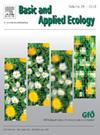Forest birds maintain body condition in Alder-leaf Birch (Betula alnoides) plantations in subtropical Asia
IF 3.5
2区 环境科学与生态学
Q2 ECOLOGY
引用次数: 0
Abstract
Plantation forestry alters avian community assembly by creating homogeneous habitats with simplified vegetation structure. However, its effects on avian body condition remain poorly understood, despite the influence body condition has on survival and reproduction. We studied how plantation forestry of Alder-leaf Birch (Betula alnoides, “birch”) affects the body condition of nine forest bird species in the Indo-Burma biodiversity hotspot in southwestern China. Through mist-net sampling, we collected data on avian body condition in birch plantations and natural forests of two age classes (young and mature). We also examined other factors that might affect body condition including demographic information (age and sex), previous-day weather (rainfall and temperature), and reproductive status. Body condition scores measured using the scaled mass index (SMI) were similar between birch plantations and natural forests, indicating that birch plantations support avian body condition at levels comparable to natural forests. Age and rainfall affected the body condition of Yunnan Fulvettas (Alcippe fratercula), with adults and individuals captured after rainfall having lower SMIs. Additionally, the body condition of Rusty-capped Fulvettas (Schoeniparus dubius) and Silver-eared Mesias (Leiothrix argentauris) was positively associated with their reproductive status, though the higher SMI values may partly result from gonadal and egg development. Our study reveals not only the conservation value of birch plantations but also the effects of demographic, environmental, and reproductive factors on avian body condition. We recommend considering birch as a candidate timber species for promoting conservation in plantation forestry.
森林鸟类在亚洲亚热带桤叶桦树人工林中维持身体状况
人工林通过创造同质的栖息地和简化的植被结构来改变鸟类群落的聚集。然而,尽管身体状况对鸟类的生存和繁殖有影响,但对其对鸟类身体状况的影响仍知之甚少。在中国西南印缅生物多样性热点地区,研究了桤木叶桦林(Betula alnoides,“桦树”)人工林对9种森林鸟类身体状况的影响。采用雾网抽样的方法,采集了桦树人工林和天然林两种年龄层(幼龄和成熟期)鸟类的身体状况。我们还研究了其他可能影响身体状况的因素,包括人口统计信息(年龄和性别)、前一天的天气(降雨和温度)和生殖状况。利用尺度质量指数(SMI)测量的身体状况得分在桦树人工林和天然林之间相似,表明桦树人工林支持鸟类身体状况的水平与天然林相当。年龄和降雨影响云南富尔韦塔(Alcippe fratercula)的身体状况,降雨后捕获的成虫和个体的SMIs较低。此外,尽管较高的SMI值可能在一定程度上与性腺和卵子发育有关,但锈冠富尔维塔(Schoeniparus dubius)和银耳Mesias (Leiothrix argentauris)的身体状况与其生殖状态呈正相关。本研究不仅揭示了桦树人工林的保护价值,还揭示了人口、环境和繁殖等因素对鸟类身体状况的影响。我们建议考虑将桦木作为促进人工林保护的候选树种。
本文章由计算机程序翻译,如有差异,请以英文原文为准。
求助全文
约1分钟内获得全文
求助全文
来源期刊

Basic and Applied Ecology
环境科学-生态学
CiteScore
6.90
自引率
5.30%
发文量
103
审稿时长
10.6 weeks
期刊介绍:
Basic and Applied Ecology provides a forum in which significant advances and ideas can be rapidly communicated to a wide audience. Basic and Applied Ecology publishes original contributions, perspectives and reviews from all areas of basic and applied ecology. Ecologists from all countries are invited to publish ecological research of international interest in its pages. There is no bias with regard to taxon or geographical area.
 求助内容:
求助内容: 应助结果提醒方式:
应助结果提醒方式:


